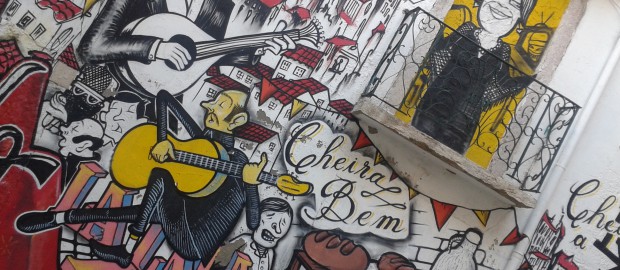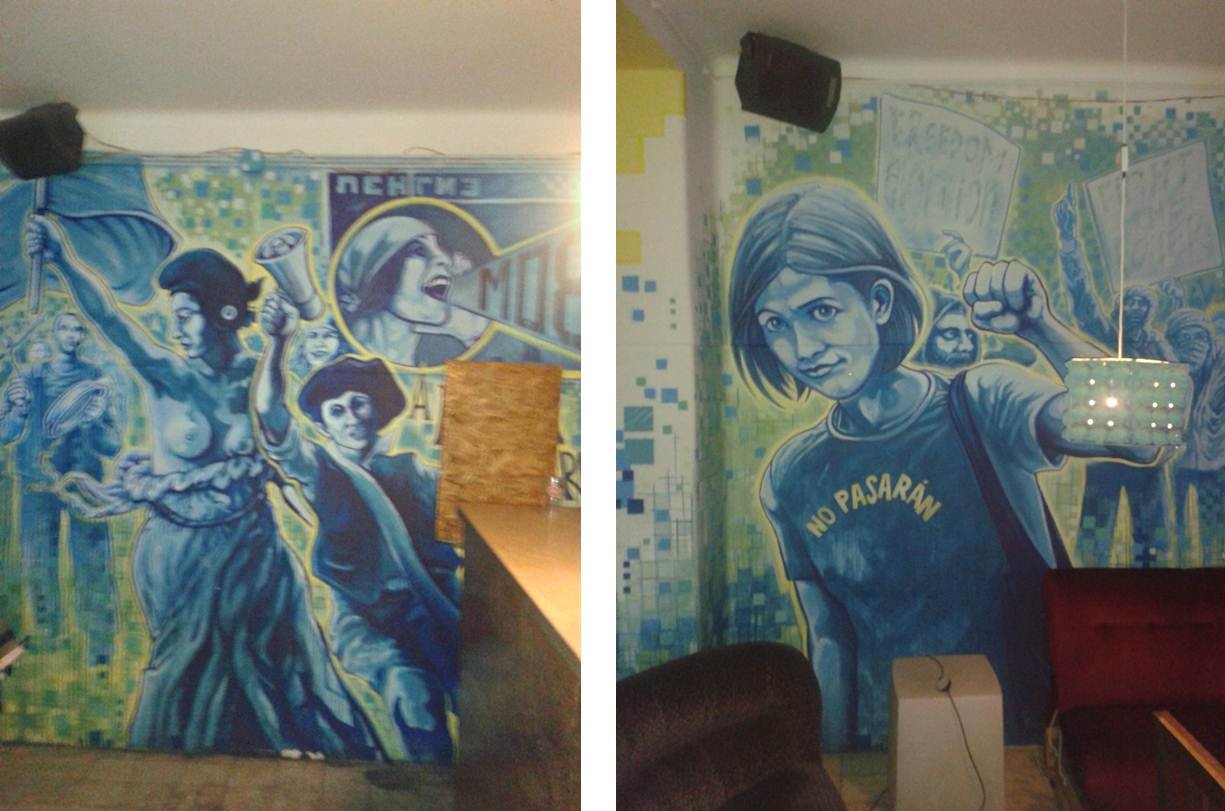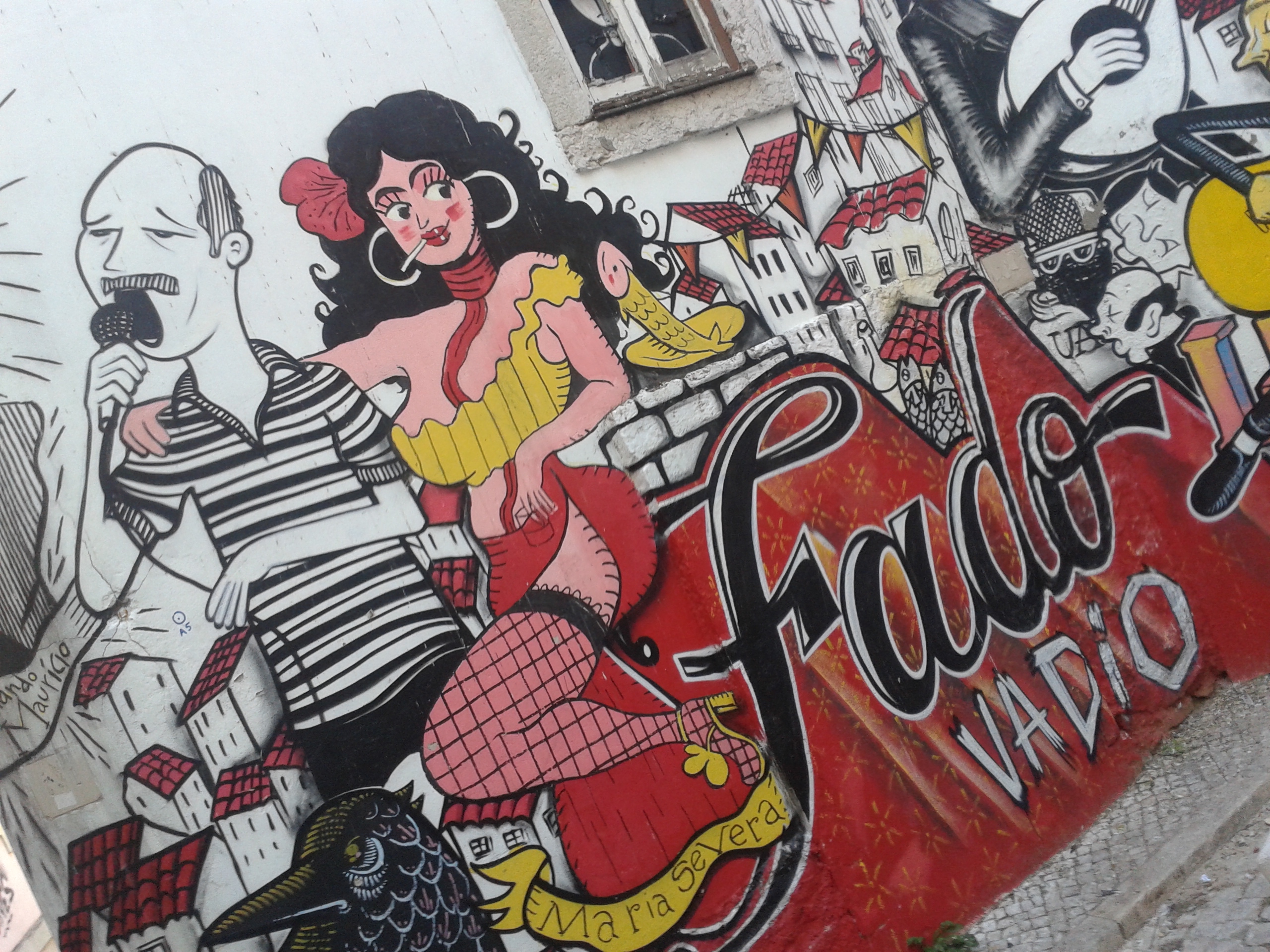Last November I was visiting Lisbon to attend a workshop in which I tackled the Spanish 15M and what I have called ‘transnational networks of indignados’. It was nice to know new friends and share ideas, works and comments with them. And of course enjoy Lisbon together given that the plan included two non-academic parallel activities. The first activity consisted of a meeting at the MOB Center placed in Barrio Alto. This is a cultural center run by two activist groups, the Precários Inflexíveis («The Inflexible Precarious Workers»), an association that fights on behalf of the precarious workers, and the cultural initiative Crew Hassan. Less than a week before the MOB had held the Fórum Precariedade e Desemprego (“Precariousness and Unemployment Forum”) organized by Precários Inflexíveis, in which participated several European activists and organizations [1].
Since 2011, these networks of activists and organizations have organized several meetings to coordinate efforts and promote joint global actions (Díez, 2013); and some of them have been held in Self Organized Social Centers, occupied buildings and other urban spaces. For instance, ‘Agora99’ held its first ‘Meeting on Debt, Rights & Democracy’ in Madrid, November 2012, in some of these spaces, such as Patio Maravillas, La Morada or Eko Carabanchel. Likewise, its last meeting in Rome, November 2013, repeated this same scheme [2].
The second activity was a guide walk through the revitalized district of the Mouraria in the historical center of Lisbon, in which an interesting process of gentrification is taking place. During the walk we visited different stimulating places and spaces which called my attention. One of these places was a mural representing the spirit of Portuguese Fado musicians such as Maria Severa. I also remember how I was talking about the Spanish ‘copla’ with an Ecuadorian researcher -in the University of Freiburg-, who asked me about Flamenco and the connections between music and socio-political claims in Spain. Indeed, Fado has being traditionally associated with the dictatorship in Portugal, although some young musicians have reclaimed this genre in the recent decades and it was also used by some singers as a form of resistance to the Salazar dictatorship.
As I have previously mentioned, in my intervention at the workshop I focused on the idea of transnational networks of indignados [3]. These networks of activists and organizations are playing a growing and active role behind the scenes, calling to join global events and reinforcing the international resonance of diverse claims and demands, which have led people in the Arab world, Europe, United States, Brazil, Turkey, and other countries worldwide, to ‘wake up’ and act inspired by powerful feelings of outrage and hope (Castells, 2012; Belli & Díez, 2013).
In some of these cases, the initial claims and demands were connected to youth culture and urban policy decision making process. “In fact, Occupy Gezi was largely organized by college student” (Gurbuz, 2013), due to environmental reasons and to the use of public space, as well as Passe Livre in Brazil advocated for free public transportation in the city of São Paulo. And for instance, the college graduate Mohamed Bouazizi, “doused himself in petrol and set himself alight when police confiscated his produce because he did not have the necessary permit to sell fruit and vegetables” [4] in the streets of the Tunisian city of Sidi Bouzid. Likewise, encampments in Spain and occupations in the United States, and other countries, constitute and claim for an alternative use of urban public space and the ‘common’ (Díez, 2013). This idea was also pointed out by Michael Hardt in the Lecture “Imagining and performing the constitution of the common”, organized by Fundación de los Comunes and MACBA, and held in Madrid the 18th of October, 2013 [5]. In October he was visiting Spain to present Declaration which deals with the recent wave of global protests and their implications. It was published by Antonio Negri and Michael Hardt in 2012. And Michael Hardt suggests that the right to the ‘common’, -characterized in distinction from both the private and the public properties-, is becoming a central demand of these chapters of indignados or occupiers.
In this last wave of global mobilization, urban spaces such as Puerta del Sol Square, Zuccotti Park or Gezi Park, have came back to be the agoras, the public squares where the Greek State cities were born, the polis that gave rise to our civilization; spaces open to commerce, culture and politics (Laraña & Diez 2012b). These urban spaces have again become in the crossroads at which thoughtful and committed citizens arrive, inspired by powerful feelings of outrage and hope, shaping hybrid and plural multitudes who express the collective discontent regarding the consequences of oligarchy which are threatening democracy itself across different countries (Díez, 2013). They occupy and protest in the squares, sleep on it and hold gatherings in urban spaces. And although they are retired from these spaces, they continue organizing public activities, assemblies or meetings in which their claims are discussed in new urban spaces. In fact, new laws are being passed in countries such as Spain, Egypt or Mexico in order to restrict the right to protest and discuss in public spaces.
However, these empowered and imaginative citizens, for sure, are going to overcome these restrictions. Given that urban space is not only the place in which they act as activists or socio-political actors, but as urban cultural pioneers injecting into the citizenship new practices, values, ideas and ways of thinking and act. New ideas and practices rooted in their political, social and economic demands, but also in a way of experience the city life that puts the emphasis on a new urban cultural paradigm: “a pro-active and engaged citizenship, sensitive to the problems of its environment, which uses the resources in an intelligent way; gets its political condition back; and is capable of generating new imaginaries and initiatives to create more equitable and sustainable environments, from a economic, social and environmental integrated perspective” (Aguirre Such, 2013, author’s translation) [6].
Likewise, this new urban cultural paradigm, as well as the current worldwide patterns of activism, emphasize the role played by emotions and collective subjectivities in these processes of transformation and social change (Belli & Díez, 2013; Belli & Cabrerizo, 2013). For instance, the fact that emotions and practical reasons are key aspects in order to explain why people participate in social movements is a solid assumption in the field of social movements (Laraña & Díez, 2012a). As well as, emotions and practical reasons are key aspects to explain the potential of cultural pioneers to create new ideas, practices and realities, whether in the sphere of urbanism or environmental behavior (Assadourian, 2010). They are indeed people who consider themselves responsible citizens, living in societies and environments threatened by the interests and the decisions of economic and political elites disconnected from citizens. And these are practical reasons that trigger people’s emotions, such as outrage, distrust or hope, and lead them to act in consequence.
In order to delve into this issue and show the role played by emotions in these processes, it is interesting to come back to the connections between music and activism, and take a look at how urban spaces become in the agora in which citizens discuss and protests, but also in the arena in which these pioneers put into practice this new urban cultural paradigm.
In May 2013, during the celebration activities of the 15M second anniversary in Madrid, I could observe an interesting musical performance of the Solfonica, an orchestra linked to the Spanish chapter of the indignados movement and Global uprisings. At Sol Square in Madrid, Solfonica performed, among others, two songs, whose melodies were popular folk ones in the course of the Civil War among the supporters of the Spanish Republic. These two songs are based on traditional ‘coplas’, whose lyrics were adapted during the 1930s by the Andalucian poet and theatre director Federico García Lorca. A few years later, using the same melody of one of these songs, “Los cuatro muleros” (The four muleteer), new lyrics were written making reference to the Defense of Madrid in the Spanish Civil War.
This song was titled “Puente de los franceses”. From July 1936 to March 1939, the city of Madrid was loyal to the Republican Government and was besieged by the Nationalist troops under Francisco Franco. Although the disputes and clashes between communists and anarchists were common during the siege, the city of Madrid held out for three years. The lyrics called to resist the attacks of the Nationalist troops:
“Puente de los franceses (3 times); my mommy, nobody passes you, nobody passes you. Because the Madrilenians (3 times); how well they guard you!, how well they guard you! […] Madrid how well you resist! (3 times); my mommy, the bombards!, the bombards!. The Madrilenians laugh of the bombs! (3 times); my mommy, the Madrilenians!, the Madrilenians!” (author’s translation).
In contrast, the Solfonica version of “Los cuatro muleros”, or “Puente de los Franceses” in its ‘republican version’, the main chorus makes reference for example to Puerta del Sol Square or the indignados (outraged people). And nowadays it has become in a symbolic hymn of the Madrileneans indignados:
“From La Puerta del Sol (3 times); my mommy, nobody leaves!, nobody leaves!. The outraged people! (3 times); my mommy, how well they guard you!, how well they guard you! […] Madrid how well you resist! (3 times); my mommy, so much sacking!, so much sacking!. You withstand the cuts! (3 times); citizenship, and up to your neck in it!, and up to your neck in it!” (author’s translation).
Likewise, the Solfonica includes in his musical repertoire other songs with melodies of Verdi, Beethoven or Bach, and also a traditional Spanish Zarzuela. But Solfonica also performs pop music, including The Beatles. One of its most emotive actions was a flashmob in which some members performed “Here comes the sun” in an unemployment office. This performance was promoted by Carne Cruda, a radio program well-known for its criticisms of Spanish society, economics and politics, which was cancelled from national radio in 2012 summer season.
Many of the songs’ lyrics are revised and adapted by the Solfonica, according to the claims and demands of this movement, but also making reference to main traits of its collective identity (Melucci, 1989, 1995). For instance, this Orchestra also usually performs two other songs: “Canto a la libertad” (Song to freedom) and “The people’s song”. The first is a protest poem-song from the mid-seventies written by the Aragonese singer and poet Jose Antonio Labordeta. Just like other protest songs, demanding freedom and the end of Franco’s dictatorship, it was popular during the Spanish transition to democracy. In this particular case the original lyrics have not been modified by the Solfonica Orchestra. The second song is from the musical Les Misérables, based on Victor Hugo novel of the same name and set in the revolutionary Paris of the 19th century, particularly in the liberal revolutions of 1830. In this particular case, the lyrics have been adapted by the Solfonica, maintaining some lyrics of the original but including new ones. On the one hand, the original represents an emotional and theatrical call to barricades against the “slavery” [of Monarchy] in clear reference to the revolutionary values of freedom characteristic of that epoch. On the other hand, the Solfonica version maintains the emotional tone and calls to action, dignity and social change, without making reference to violent revolution or to slavery, as in the original lyrics from the musical Les Misérables. But it also calls to hope as a counter-emotion (Flam, 2005) that allows counteracting and confronting fear and distrust.
“When the People raises his voice no one can stop it. Do you feel the strength of his singing that will not be subjected? Hear strong in your inner man, how it resounds as a drum. It is the certainly of a future in which the SUN will come out. Repression, violence or fear; they are not going to frighten us. Cowardice never gave any People dignity. I want another world; do you join me to fight?” (author`s translation)
In its last project, Solfonica has collaborated with some 15M groups, assemblies and activists on the Opera Buffa “El crepúsculo del ladrillo” (The twilight of the brick). Although this ‘comic opera’ parodies the Spanish building bubble, it also denounces the connivance between politicians and plutocratic groups, and their responsibility in the current crisis (Laraña & Díez, 2012a). Additionally, it criticizes the measures implemented by the Spanish Governments in connivance with the European Union and its ‘technicians’, who are also identified as responsible for the current situation.
The acting in the former Tobacco Factory of Madrid, nowadays reconverted into the Self Organized Social Center La Tabacalera de Lavapiés, concludes with a poem of Miguel Hernandez, “Vientos del pueblo me llevan” (Winds of the people carry me along). This Spanish poet supported the Spanish Republic during the Civil War and was arrested and jailed several times after the conflict ended. He finally died in prison from tuberculosis in 1942. However, despite the fact that some of the lyrics make reference to the Spanish Republic and seem to have a high ideological charge, it should be taken into consideration that this social movement shows a transversal character and ideological pluralism (Laraña & Díez, 2012a; Diez, 2013), as well as its musical brand: “in the Solfonica not all members think the same, but sing together” [7].
Solfonica’s performances go beyond ideologies, the exhibition of claims and demands, or the mere musical accompaniment to the demonstrations and protests in Madrid. Emotions and creativity that come from the music provide an emotional connection and reinforce the collective identity of the activists and sympathizers who occupy a particular urban space. Performances like these provide meaning to the actions of the activists and supporters by which social movements construct their collective identity. And this informs about a process of emotional liberation regarding the ruling political and economic institutions and their elites (Belli & Díez, 2013), and the old urban paradigm. In this way, occupations, meetings and assemblies in squares, neighborhoods and self-organized Social Centers reinforce a process of cognitive and emotional liberation that strengthen social change by putting the emphasis on the ‘common’ and participatory forms of democracy.
————————————-
Some ideas of this text have been presented in Lisbon, at the workshop “Transnational public participation and social movement activism” (November).
Referencias
Assadourian, Erik. 2010. “The rise and fall of consumer cultures”, in State of the world 2010. Transforming cultures: from consumerism to sustainability, New York: WW Norton.
Belli, Simone & Díez, Rubén. 2013. “Emociones en la plaza y en la pantalla”, presented in the meeting 15MP2P. Barcelona, July, 2013.
Belli, Simone & Cabrerizo, Sergio. 2013. “¿Cómo sostener la multitud y visibilizar sus emociones? Pensando #occupy como transformación urbana de las prácticas cotidianas en el espacio público”, URBS. Revista de Estudios Urbanos y Ciencias Sociales, 3(2), 81-91.
Castells, Manuel. 2012. Networks of outrage and hope. Social movements in the Internet Age. Cambridge: Polity Press.
Díez, Rubén. 2013. “An approach to the Spanish 15M and the transnational networks of ‘indignados’: ideology, identity & method”, presented in the workshop ‘Transnational public participation and social movement activism’. Lisbon, November, 2013.
Flam, Helena. 2005. «Emotions’ map: a research agenda», in Emotions and Social Movements, edited by Helena Flam, y Debra King, London: Routledge.
Gurbuz, Mustafa. 2013. “What is Happening in Turkey: New Episodes of Contention”. Mobilizing Ideas, 11th June 2013.
Laraña, Enrique & Díez, Rubén. 2012a. “Las raíces del movimiento 15-M. Orden social e indignación moral”, Revista Española del Tercer Sector, nº 20: 105-144.
Laraña, Enrique & Díez, Rubén. 2012b. “El aniversario de un movimiento internacional. Continuidad y poder de persuasión colectiva del 15-M” in Crisis y cambios en la sociedad contemporánea: Comunicación y problemas sociales, edited by Mª Dolores Cáceres y Antonio Lucas. Madrid: Fragua.
Melucci, Alberto. 1989. Nomads of the Present. Philadelphia: Temple University Press.
Melucci, Alberto. 1995. “The process of collective identity” in Social Movements and Culture, edited by Klandermans, B. and Johnston, H. Minneapolis: University of Minnesota Press.







Comments Closed
2 Comments